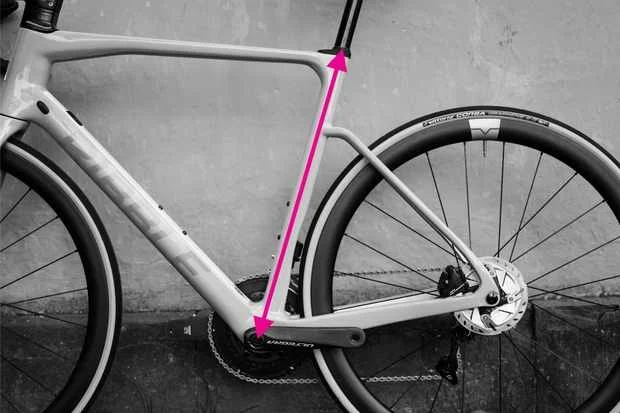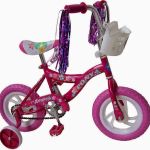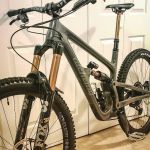
- Understanding Bike Frame Geometry
- The Impact of Riding Position
- Choosing the Right Frame Angle
- Different Bike Frame Types and Their Geometries
- Adjusting Your Bike for Better Fit
1. Understanding Bike Frame Geometry
Bike frame geometry is the blueprint that defines how a bike will handle, feel, and fit. It’s the combination of frame angles, lengths, and overall design that impacts your comfort, efficiency, and performance. The geometry of a bike frame determines factors like the reach, the stack height, the head tube angle, and the seat tube angle, all of which influence how a bike rides and how comfortable you feel during long rides.
When choosing a bike, understanding geometry is essential because it determines whether the bike suits your riding style, whether it’s for commuting, touring, racing, or leisure riding. The right geometry can make the difference between a smooth, enjoyable ride and one that leaves you feeling fatigued or uncomfortable.
2. The Impact of Riding Position
Your riding position plays a major role in determining the ideal bike frame geometry for you. Whether you prefer an upright, relaxed riding position or a more aggressive, aero position will dictate the type of geometry you should look for in a bike. Let's dive deeper into how your riding position affects the bike geometry.
2.1 Upright Riding Position
If you ride in a more upright position, like on a comfort or hybrid bike, you’ll benefit from a geometry that prioritizes stability, comfort, and ease of use. The head tube angle on such bikes is usually slacker, and the handlebars are positioned higher, allowing for a more relaxed posture. These bikes are ideal for casual riding, commuting, or leisure rides.
2.2 Aggressive Riding Position
On the other hand, if you’re more focused on speed, performance, or racing, you’ll likely lean toward a geometry designed for an aggressive, aerodynamic position. Racing bikes, for example, have a steeper head tube angle and lower handlebars, putting the rider in a more crouched, aero position. This geometry allows for maximum power transfer, reducing wind resistance and improving overall speed.
2.3 Balanced Riding Position
For cyclists who need a balance of comfort and performance, like touring cyclists or endurance riders, a more neutral geometry is ideal. These bikes typically have a mid-range head tube angle and a slightly higher front end, allowing for a comfortable but still performance-oriented posture that works well for long rides.
3. Choosing the Right Frame Angle
The frame angles, specifically the head tube angle and seat tube angle, are crucial factors in determining the bike's handling and stability. Let's explore how these angles affect the ride:
3.1 Head Tube Angle
The head tube angle determines how responsive the bike is to steering. A steeper head tube angle (typically found in road bikes) results in quicker, more agile handling, which is ideal for racing. A slacker head tube angle (typically found in mountain bikes) provides better stability at high speeds, making it easier to ride over rough terrain.
3.2 Seat Tube Angle
The seat tube angle influences your pedaling position and how your power is transferred to the pedals. A steeper seat tube angle positions the rider further forward, which can be more efficient for power transfer in a racing position. A more relaxed angle shifts your body back slightly, making it more comfortable for long rides and providing better stability.
4. Different Bike Frame Types and Their Geometries
Different types of bikes come with their own unique geometries tailored to specific riding styles and uses. Here are some common bike frame types and their respective geometries:
4.1 Road Bikes
Road bikes are designed for speed and efficiency on smooth pavement. They feature a more aggressive geometry, with a steep head tube angle and a low bottom bracket. This setup allows for faster speeds and better aerodynamics but may not be as comfortable for long rides due to the stretched-out position.
4.2 Mountain Bikes
Mountain bikes are built for off-road riding and rugged trails. They tend to have a slacker head tube angle, which provides better stability when navigating rough terrain. The geometry is also designed to allow for more upright seating, which enhances control on bumpy surfaces.
4.3 Hybrid Bikes
Hybrid bikes combine elements of road and mountain bikes, making them perfect for casual riders who want a bit of both. The geometry of hybrid bikes is more upright and relaxed, with a moderate head tube angle for stability and comfort on a variety of terrains.
4.4 Touring Bikes
Touring bikes are designed for long-distance comfort. They offer a more relaxed geometry with a higher head tube angle and a longer wheelbase, making them stable on long rides and loaded with gear. The focus is on comfort and endurance, ensuring riders can tackle long distances with ease.
5. Adjusting Your Bike for Better Fit
Once you’ve chosen a bike with the right geometry, it's essential to fine-tune the fit to suit your body. Here are a few adjustments you can make to ensure your bike feels just right:
5.1 Adjusting the Seat Height
The seat height is one of the most important factors in achieving a comfortable riding position. To ensure proper leg extension, your saddle should be positioned so that your leg has a slight bend when the pedal is at its lowest point.
5.2 Adjusting the Handlebar Position
Handlebars can be raised or lowered to adjust the riding position. If you're aiming for comfort, raise the handlebars for a more upright posture. For a more aggressive position, lower the handlebars to enhance aerodynamics and reduce wind resistance.
5.3 Fine-tuning the Reach
The reach refers to the distance between the saddle and handlebars. Adjusting the reach can help you find a balance between comfort and performance, allowing you to maintain a natural riding posture without straining your back or shoulders.
In conclusion, choosing the right bike frame geometry based on your riding position is essential to ensure comfort, efficiency, and performance. Whether you're cycling for leisure, endurance, or speed, understanding your geometry and making the necessary adjustments can greatly improve your riding experience. For more information on the best bikes for your needs and the right frame geometry, visit Cycling Guider, where you can find expert recommendations and top-quality bikes suited to your riding style.







 Billet BMX5.0 (2 reviews)
Billet BMX5.0 (2 reviews) Far East Children Bicycle Factory1.0 (1 reviews)
Far East Children Bicycle Factory1.0 (1 reviews) Archer Motorsports, Inc.4.0 (8 reviews)
Archer Motorsports, Inc.4.0 (8 reviews) YEP Bike Works4.0 (55 reviews)
YEP Bike Works4.0 (55 reviews) Gorham Bike & Ski4.0 (498 reviews)
Gorham Bike & Ski4.0 (498 reviews) Alchemy Bikes4.0 (37 reviews)
Alchemy Bikes4.0 (37 reviews) How to Teach Kids to Ride a Bike: A Step-by-Step Guide for Parents
How to Teach Kids to Ride a Bike: A Step-by-Step Guide for Parents Tips for Riding on Busy City Streets: Smart Strategies for Urban Cyclists
Tips for Riding on Busy City Streets: Smart Strategies for Urban Cyclists Best US National Parks for Mountain Biking: Ride Epic Trails Across America
Best US National Parks for Mountain Biking: Ride Epic Trails Across America Best Aero Helmets for Time Trials and Racing
Best Aero Helmets for Time Trials and Racing How to Clean and Lubricate Your Bike Chain Like a Pro
How to Clean and Lubricate Your Bike Chain Like a Pro 10 Must-Have Items for Long-Distance Cycling Trips
10 Must-Have Items for Long-Distance Cycling Trips